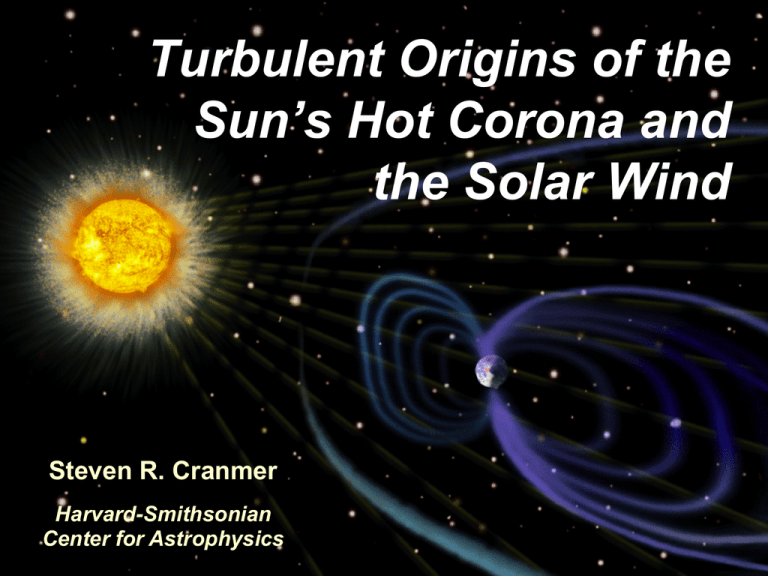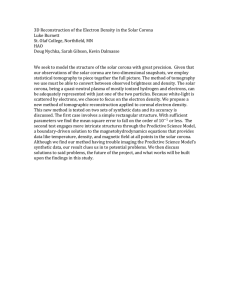Turbulent Origins of the Sun’s Hot Corona and the Solar Wind
advertisement

Turbulent Origins of the Sun’s Hot Corona and the Solar Wind Steven R. Cranmer Harvard-Smithsonian Center for Astrophysics Turbulent Origins of the Sun’s Corona & Solar Wind S. R. Cranmer, 12 March 2010, London Turbulent Origins of the Sun’s Hot Corona and the Solar Wind Outline: 1. Solar overview: Our complex “variable star” 2. How do we measure waves & turbulence? 3. Coronal heating & solar wind acceleration Steven R. Cranmer Harvard-Smithsonian Center for Astrophysics Turbulent Origins of the Sun’s Corona & Solar Wind S. R. Cranmer, 12 March 2010, London The Sun’s overall structure Core: • Nuclear reactions fuse hydrogen atoms into helium. Radiation Zone: • Photons bounce around in the dense plasma, taking millions of years to escape the Sun. Convection Zone: • Energy is transported by boiling, convective motions. Photosphere: • Photons stop bouncing, and start escaping freely. Corona: • Outer atmosphere where gas is heated from ~5800 K to several million degrees! Turbulent Origins of the Sun’s Corona & Solar Wind S. R. Cranmer, 12 March 2010, London The extended solar atmosphere Everywhere one looks, the plasma is “out of equilibrium!” Turbulent Origins of the Sun’s Corona & Solar Wind S. R. Cranmer, 12 March 2010, London The solar photosphere • In visible light, we see top of the convective zone (wide range of time/space scales): β << 1 β~1 β>1 Turbulent Origins of the Sun’s Corona & Solar Wind S. R. Cranmer, 12 March 2010, London The solar chromosphere • After T drops to ~4000 K, it rises again to ~20 000 K over 0.002 Rsun of height. • Observations of this region show shocks, thin “spicules,” and an apparently larger-scale set of convective cells (“super-granulation”). • Most… but not all… material ejected in spicules appears to fall back down. Hinode/SOT Turbulent Origins of the Sun’s Corona & Solar Wind S. R. Cranmer, 12 March 2010, London The solar corona • Plasma at 106 K emits most of its spectrum in the UV and X-ray . . . Coronal hole (open) “Quiet” regions Active regions Turbulent Origins of the Sun’s Corona & Solar Wind S. R. Cranmer, 12 March 2010, London The coronal heating problem • We still do not understand the physical processes responsible for heating up the coronal plasma. A lot of the heating occurs in a narrow “shell.” • Most suggested ideas involve 3 general steps: 1. Churning convective motions that tangle up magnetic fields on the surface. 2. Energy is stored in tiny twisted & braided “magnetic flux tubes.” 3. Something releases this energy as heat. Particle-particle collisions? Wave-particle interactions? Turbulent Origins of the Sun’s Corona & Solar Wind S. R. Cranmer, 12 March 2010, London A small fraction of magnetic flux is OPEN Peter (2001) Fisk (2005) Tu et al. (2005) Turbulent Origins of the Sun’s Corona & Solar Wind S. R. Cranmer, 12 March 2010, London The solar wind: discovery • 1860–1950: Evidence slowly builds for outflowing magnetized plasma in the solar system: • solar flares aurora, telegraph snafus, geomagnetic “storms” • comet ion tails point anti-sunward (no matter comet’s motion) • 1958: Eugene Parker proposed that the hot corona provides enough gas pressure to counteract gravity and accelerate a “solar wind.” Turbulent Origins of the Sun’s Corona & Solar Wind S. R. Cranmer, 12 March 2010, London In situ solar wind: properties • Mariner 2 (1962): first direct confirmation of continuous fast & slow solar wind. • Uncertainties about which type is “ambient” persisted because measurements were limited to the ecliptic plane … • 1990s: Ulysses left the ecliptic; provided first 3D view of the wind’s source regions. • 1970s: Helios (0.3–1 AU). 2007: Voyagers @ term. shock! speed (km/s) density fast slow 600–800 300–500 low high variability smooth + waves chaotic temperatures Tion >> Tp > Te all ~equal abundances photospheric more low-FIP Turbulent Origins of the Sun’s Corona & Solar Wind S. R. Cranmer, 12 March 2010, London Outline: 1. Solar overview: Our complex “variable star” 2. How do we measure solar waves & turbulence? 3. Coronal heating & solar wind acceleration Turbulent Origins of the Sun’s Corona & Solar Wind S. R. Cranmer, 12 March 2010, London Waves & turbulence in the photosphere • Helioseismology: direct probe of wave oscillations below the photosphere (via modulations in intensity & Doppler velocity) • How much of that wave energy “leaks” up into the corona & solar wind? Still a topic of vigorous debate! • Measuring horizontal motions of magnetic flux tubes is more difficult . . . but may be more important? splitting/merging torsion 0.1″ bending (kink-mode wave) Turbulent Origins of the Sun’s Corona & Solar Wind longitudinal flow/wave S. R. Cranmer, 12 March 2010, London Waves in the corona • Remote sensing provides several direct (and indirect) detection techniques: • Intensity modulations . . . • Motion tracking in images . . . • Doppler shifts . . . • Doppler broadening . . . • Radio sounding . . . SOHO/LASCO (Stenborg & Cobelli 2003) Turbulent Origins of the Sun’s Corona & Solar Wind S. R. Cranmer, 12 March 2010, London Wavelike motions in the corona • Remote sensing provides several direct (and indirect) detection techniques: • Intensity modulations . . . • Motion tracking in images . . . Tomczyk et al. (2007) • Doppler shifts . . . • Doppler broadening . . . • Radio sounding . . . Turbulent Origins of the Sun’s Corona & Solar Wind S. R. Cranmer, 12 March 2010, London Wavelike motions in the corona • Remote sensing provides several direct (and indirect) detection techniques: • The Ultraviolet Coronagraph Spectrometer (UVCS) on SOHO has measured plasma properties of protons, ions, and electrons in low-density collisionless regions of the corona (1.5 to 10 solar radii). • Ion cyclotron waves (10–10,000 Hz) have been suggested as a “natural” energy source that can be tapped to preferentially heat & accelerate the heavy ions, as observed. Turbulent Origins of the Sun’s Corona & Solar Wind S. R. Cranmer, 12 March 2010, London In situ fluctuations & turbulence • Fourier transform of B(t), v(t), etc., into frequency: Magnetic Power f -1 “energy containing range” f -5/3 “inertial range” The inertial range is a “pipeline” for transporting magnetic energy from the large scales to the small scales, where dissipation can occur. few hours Turbulent Origins of the Sun’s Corona & Solar Wind f -3 “dissipation range” 0.5 Hz S. R. Cranmer, 12 March 2010, London Outline: 1. Solar overview: Our complex “variable star” 2. How do we measure solar waves & turbulence? 3. Coronal heating & solar wind acceleration Turbulent Origins of the Sun’s Corona & Solar Wind S. R. Cranmer, 12 March 2010, London What processes drive solar wind acceleration? Two broad paradigms have emerged . . . • Wave/Turbulence-Driven (WTD) models, in which flux tubes “stay open” • Reconnection/Loop-Opening (RLO) models, in which mass/energy is injected from closed-field regions. vs. • There’s a natural appeal to the RLO idea, since only a small fraction of the Sun’s magnetic flux is open. Open flux tubes are always near closed loops! • The “magnetic carpet” is continuously churning. • Open-field regions show frequent coronal jets (SOHO, Hinode/XRT). Turbulent Origins of the Sun’s Corona & Solar Wind S. R. Cranmer, 12 March 2010, London Waves & turbulence in open flux tubes • Photospheric flux tubes are shaken by an observed spectrum of horizontal motions. • Alfvén waves propagate along the field, and partly reflect back down (non-WKB). • Nonlinear couplings allow a (mainly perpendicular) cascade, terminated by damping. (Heinemann & Olbert 1980; Hollweg 1981, 1986; Velli 1993; Matthaeus et al. 1999; Dmitruk et al. 2001, 2002; Cranmer & van Ballegooijen 2003, 2005; Verdini et al. 2005; Oughton et al. 2006; many others) Turbulent Origins of the Sun’s Corona & Solar Wind S. R. Cranmer, 12 March 2010, London Results of wave/turbulence models • Cranmer et al. (2007) computed self-consistent solutions for waves & background plasma along flux tubes going from the photosphere to the heliosphere. • Only free parameters: radial magnetic field & photospheric wave properties. (No arbitrary “coronal heating functions” were used.) • Self-consistent coronal heating comes from gradual Alfvén wave reflection & turbulent dissipation. • Is Parker’s “critical point” above or below where most of the heating occurs? • Models match most observed trends of plasma parameters vs. wind speed at 1 AU. Turbulent Origins of the Sun’s Corona & Solar Wind S. R. Cranmer, 12 March 2010, London Understanding physics reaps practical benefits Self-consistent WTD models Z– 3D global MHD models Real-time “space weather” predictions? Z+ Z– Turbulent Origins of the Sun’s Corona & Solar Wind S. R. Cranmer, 12 March 2010, London Conclusions • It is becoming easier to include “real physics” in 1D → 2D → 3D models of the complex Sun-heliosphere system. • Theoretical advances in MHD turbulence continue to help improve our understanding about coronal heating and solar wind acceleration. vs. • We still do not have complete enough observational constraints to be able to choose between competing theories. For more information: http://www.cfa.harvard.edu/~scranmer/ Turbulent Origins of the Sun’s Corona & Solar Wind S. R. Cranmer, 12 March 2010, London


![30 — The Sun [Revision : 1.1]](http://s3.studylib.net/store/data/008424494_1-d5dfc28926e982e7bb73a0c64665bcf7-300x300.png)
